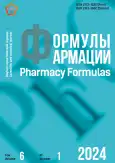The study of indicators of authenticity and goodness of flowers of narrow-leaved lavender (Lavandula angustifolia L.)
- Authors: Whaley A.K.1, Whaley A.O.1, Zhokhova E.V.1, Suloev I.S.1, Abdumazhidova I.O.2, Farmanova N.T.2, Yakovlev G.P.1
-
Affiliations:
- Saint Petersburg State Chemical and Pharmaceutical University
- Tashkent Pharmaceutical Institute
- Issue: Vol 6, No 1 (2024)
- Pages: 44-51
- Section: Biological sciences
- URL: https://journals.rcsi.science/PharmForm/article/view/256786
- DOI: https://doi.org/10.17816/phf629154
- ID: 256786
Cite item
Full Text
Abstract
The study is dedicated to the analysis of the cultural and medicinal plant Lavandula angustifolia Mill. from the Lamiaceae Martinov family. The plant is widely used in the food and perfume-cosmetic industries, as well as in traditional medicine for treating various diseases including rheumatism and migraines. The research focuses on the analysis of phenolic compounds and terpenoids, which are the main pharmacologically active components of narrow-leaved lavender. Phenolic compounds include flavonoids, phenolic acids, and coumarins, while terpenoids such as linalool and linalyl acetate are responsible for the aromatic essential oil. The experiment involved studying the quantitative content of flavonoids, chromatographic analysis of secondary metabolites, and microscopic analysis of the structure of narrow-leaved lavender flowers. The obtained data expand the nomenclature of pharmacopoeial herbal raw materials. The quantitative content of flavonoids and the profile of major polyphenolic secondary components have been established. These results can serve as a basis for standardization and quality assessment of narrow-leaved lavender flowers, as well as for further phytochemical and pharmacological research.
Full Text
##article.viewOnOriginalSite##About the authors
Andrey K. Whaley
Saint Petersburg State Chemical and Pharmaceutical University
Email: andrey.ueyli@pharminnotech.com
PhD in Pharmacy, Acting Head of the Department of Pharmacognosy
Russian Federation, Saint PetersburgAnastasia O. Whaley
Saint Petersburg State Chemical and Pharmaceutical University
Email: asty.ponkratova@spcpu.ru
PhD in Pharmacy, Junior Researcher at the Department of Pharmacognosy
Russian Federation, Saint PetersburgElena V. Zhokhova
Saint Petersburg State Chemical and Pharmaceutical University
Email: elena.zhohova@pharminnotech.com
PhD in Pharmacist, Associate Professor of the Department of Pharmacognosy
Russian Federation, Saint PetersburgIvan S. Suloev
Saint Petersburg State Chemical and Pharmaceutical University
Email: Suloev.Ivan@pharminnotech.com
PhD. Pharmacist, Associate Professor of the Department of Pharmacognosy
Russian Federation, Saint PetersburgIstora O. Abdumazhidova
Tashkent Pharmaceutical Institute
Email: abdumazidovaistora@gmail.com
Assistant Professor at the Department of Pharmacognosy
Uzbekistan, TashkentNodira T. Farmanova
Tashkent Pharmaceutical Institute
Author for correspondence.
Email: farmanovan70@mail.ru
Doctor Chemical Sciences, Associate Professor, Head of the Department of Pharmacognosy
Uzbekistan, TashkentGennady P. Yakovlev
Saint Petersburg State Chemical and Pharmaceutical University
Email: gennady.yakovlev@pharminnotech.com
D.Sc. in Biology, Professor Department of Pharmacognosy
Russian Federation, Saint PetersburgReferences
- Prusinowska R., Śmigielski K. B. Composition, biological properties and therapeutic effects of lavender (Lavandula angustifolia L.) – A Review. Herba Polonica. 2014;60:56–66. doi: 10.2478/hepo-2014-0010.
- Batiha G. E., Teibo J. O., Wasef L., Shaheen H. M., Akomolafe A. P., Teibo T. K.A., Al-Kuraishy HM, Al-Garbeeb A. I., Alexiou A., Papadakis M. A review of the bioactive components and pharmacological properties of Lavandula species. Naunyn Schmiedebergs Arch Pharmacol. 2023;396(5):877–900. doi: 10.1007/s00210-023-02392-x.
- Djenane D., Aïder M., Yangüela J., Idir L., Gómez D., Roncalés P. Antioxidant and antibacterial effects of Lavandula and Mentha essential oils in minced beef inoculated with E. coli O157:H7 and S. aureus during storage at abuse refrigeration temperature. Meat Sci. 2012 Dec;92(4): 667–74. doi: 10.1016/j.meatsci.2012.06.019.
- Miloš Nikolić, Katarina K. Jovanović, Tatjana Marković, Dejan Marković, Nevenka Gligorijević, Siniša Radulović, Marina Soković. Chemical composition, antimicrobial, and cytotoxic properties of five Lamiaceae essential oils, Industrial Crops and Products, Volume 61, 2014, Pages 225–232, ISSN 0926-6690, doi: 10.1016/j.indcrop.2014.07.011.
- Chrysargyris A, Panayiotou C, Tzortzakis N (2016) Nitrogen and phosphorus levels affected plant growth, essential oil composition and antioxidant status of lavender plant (Lavandula angustifolia Mill.). Industrial Crops and Products 83, 577–586.
- Dobros N., Zawada K., Paradowska K. Phytochemical Profile and Antioxidant Activity of Lavandula angustifolia and Lavandula x intermedia Cultivars Extracted with Different Methods. Antioxidants (Basel). 2022 Apr 5;11(4):711. doi: 10.3390/antiox11040711.
- Adaszyńska-Skwirzyńska M, Dzięcioł M. Comparison of phenolic acids and flavonoids contents in various cultivars and parts of common lavender (Lavandula angustifolia) derived from Poland. Nat Prod Res. 2017 Nov;31(21): 2575–2580. doi: 10.1080/14786419.2017.1320792.
- Wells R., Truong F., Adal A. M., Sarker L. S., Mahmoud S. S. Lavandula essential oils: A current review of applications in medicinal, food, and cosmetic industries of lavender. Nat Prod Commun. 2018;13:10.
- Suloev I. S., Ponkratova A. O., Dudetskaya, N. A., Teslov L. S., Luzhanin V. G. Standardization of Canadian goldenrod (Sol-idago canadensis) herb. Farmaciya (Pharmacy) 2020, 69(8)13–20. doi: 10.29296/25419218-2020-08-02.
- Dias M. C., Pinto D., Silva A. M. S. Plant Flavonoids: Chemical Characteristics and Biological Activity. Molecules 2021, 26, 5377. doi: 10.3390/molecules26175377.
- Renata Nurzynska-Wierdak., G. Zawislak. Chemical composition and antioxidant activity of lavender (Lavandula angustifolia Mill.) aboveground parts. Acta Scientiarum Polonorum-hortorum Cultus, (2016);15(5)
- Koycheva I. K., Vasileva L. V., Amirova K. M., Marchev A. S., Balcheva-Sivenova Z. P., Georgiev MI. Biotechnologically Produced Lavandula angustifolia Mill. Extract Rich in Rosmarinic Acid Resolves Psoriasis-Related Inflammation Through Janus Kinase/Signal Transducer and Activator of Transcription Signaling. Front Pharmacol. 2021 Apr 27;12:680168. doi: 10.3389/fphar.2021.680168
- Gosudarstvennaya farmakopeya Respubliki Belarus’. V 3 t. T. 2 Kontrol’ kachestva vspomogatel’nykh veshchestv i lekarstvennogo rastitel’nogo syr’ya / UP “Tsentr ekspertiz i ispytanii v zdravookhranenii”; pod obshch. Red. A. A. Sheryakova. – Molodechno: “Tipografiya “Pobeda”, 2008. – 472 p. (In. Russ).
- Enache M. Microscopic characteristics of some Lamiaceae species – a selection of light microscopy images / M. Enache, A. Neagoie // Scientific Bulletin. Series F. Biotechnologies. 2020. Vol. XXIV. No. 2. P. 211–220.
Supplementary files











